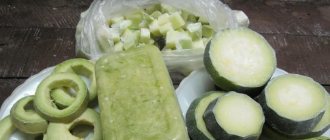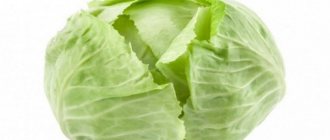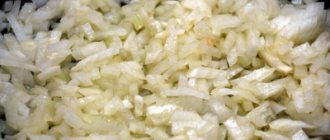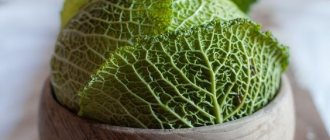Vegetables and fruits quickly cooled to -18°C are second only to fresh fruits and leaves in terms of the amount of nutrients. Freezing cabbage in the freezer is an easy way to preserve vitamin products for the winter.
The vegetable plant is rich in water (90% by weight), so there are features of preparation for freezing and subsequent use.
Let's take a closer look at whether and how to properly freeze fresh cabbage for the winter in order to store it in the freezer.
Storage without loss of beneficial properties
Any method of storage and cooking leads to a change in the composition of vegetables.
It is advisable to consume fruits or other parts of plants fresh . If for some reason this is not possible or there is no basement with suitable conditions, then the best alternative is freezing.
Some food technologists and nutritionists recommend not freezing cabbage due to its high water content.
The moisture in the freezer evaporates quickly. The product loses some of its beneficial properties and the taste changes after defrosting. Benefits of freezing:
- an easy way to preserve vegetables for the winter;
- easy preparation and handling before cooling;
- long-term storage without significant loss of quality;
- saving time when preparing food.
Freezing takes first place in the unofficial ranking of methods for storing fruits and vegetables.
The method makes it possible to save up to 80–90% of the beneficial properties of vegetables. After drying, approximately 60–70% of the original amount remains of vitamins.
Is it possible to freeze shredded white cabbage?
Cabbage can also be frozen in shredded form. The chopped cabbage should be placed into portioned bags, the air should be released from them and placed in the freezer for further freezing. If the cabbage is a little bitter, then before freezing it should be immersed in boiling water in shredded form for a few seconds. Then leave the cabbage in a colander to drain the water. After this, it should be laid out on a dry cotton towel, and only then packaged in bags for freezing.
Before use, shredded cabbage is not defrosted, but placed immediately in boiling water, broth or in a heated frying pan with oil. This cabbage is prepared very quickly, as it becomes soft after freezing.
How to prepare vegetables and containers for freezing for the winter?
Vegetables must be processed as quickly as possible after purchase. Quick preparation for storage in the freezer involves peeling the top leaves of the head of cabbage to freeze whole. It will take a little more time to remove the leaves from the forks and cut the cabbage into strips.
How to prepare cabbages:
Remove all outer leaves and carefully cut out the core.- Before freezing the whole head, rinse it in cold water.
- If you need a preparation for cabbage rolls, then cut the head in the middle with a sharp knife into 2 halves and remove the leaves.
- If you are making stock for borscht, then divide each half of the head into 2 more parts to make 4 pieces.
- Remove the core. Freeze as is or chop finely. White and red cabbage are usually shredded and cut into narrow strips.
Before freezing, vegetables are blanched - treated with hot water or steam. In this way, air is removed from plant tissues, so the shelf life is extended. The proportions of vegetables and water are 1:4. For 2-3 heads of cabbage take 2 tbsp. l. salt.
Instructions:
- Pour salt into the cut hole and place the fork in a container of boiling water. Wait until it boils again, reduce the heat to low. Blanch for 3 minutes. Let the water drain, then put the whole head or just the leaves in the freezer.
- Pre-blanch the fork pieces or whole leaves in salted water for 1-2 minutes.
- Soak cabbage sticks or pieces in salted boiling water for less than 1 minute.
- Remove whole heads or halves from the water using kitchen tongs and place them on a towel.
- Remove the leaves from the pan using a slotted spoon and let the water drain.
- Drain the shredded cabbage through a colander.
The processing time with boiling water depends on the consistency and size of the vegetable. The larger the head of white cabbage, the longer it takes to blanch - up to 15 minutes.
Prolonged contact with hot water worsens the taste of the leaves; they become very soft. For this reason, they blanch very quickly.
What should I store it in?
To store leaves or shredded cabbage in the freezer, use plastic containers with lids .
Rectangular containers are more practical for placement in the freezer than round ones. Disposable plastic trays are not suitable: they break easily after freezing.
A practical type of container is plastic bags . They are convenient for storing whole and chopped heads and leaves in the freezer. The bags are filled in such a way that the contents are used at a time, for example, for one pan of borscht.
Be sure to release the air from them after filling the portioned bags. On the top of the container they sign with a marker what they put in and the date of freezing. You can stick on trade price tags, sign with a pen, pencil or felt-tip pen.
It is not recommended to pack containers and bags too tightly in the freezer. Air must circulate between the foods in the refrigerator .
Selecting and preparing cabbage
Not only white cabbage, but also kohlrabi, cauliflower and even broccoli are suitable for long-term storage at sub-zero temperatures. Select only high-quality specimens without signs of rotting that meet the following requirements:
- without black spots and traces of mold;
- not overripe and collected on time;
- The structure of the vegetable is dense and correctly formed.
Heads of cabbage are carefully inspected for the presence of slugs, caterpillars or other insects. When defrosted, they inevitably end up in dishes, which reduces all the housewife’s efforts to zero. Therefore, before freezing, the top leaves are removed, the vegetable is rinsed with cold water, then doused with boiling water and wiped with a towel.
The best varieties for freezing
Early and mid-ripening varieties are not suitable for freezing. They turn into a soft mass and spoil the taste of the dish.
Experienced farmers recommend freezing late varieties:
- Glory 1305;
- Symphony;
- Present.
- Mara;
- Amager 611;
- Table;
- Filibuster;
- Gloria;
- Baby.
These varieties are practically not susceptible to cracking, diseases, and are resistant to pests. Therefore, they are ideal for freezing, as well as pickling and storing fresh in the cold.
Suitable container
It is most convenient to place the prepared cabbage parts in disposable plastic bags. In addition, special packaging with practical locks for reusable use is available. The use of plastic containers and cling film is allowed.
Methods
There are several ways to store fresh cabbage in the freezer.
Whole heads
Small and medium-sized heads are wrapped tightly in cling film. Before use, transfer from the freezer to the vegetable shelf of the refrigerator.
After the cabbage has thawed a little, remove the film and divide the head of cabbage into leaves. The uncut fork preserves nutrients better .
There is no need to blanch after freezing. The cabbage is soft enough to wrap stuffing for cabbage rolls.
The disadvantage of this storage method is that whole heads take up a lot of space. In addition, the taste of frozen vegetables differs from fresh ones.
Leaves
Each head of cabbage purchased in a store or cut from the garden must be cleaned of contaminated upper leaves and washed. It is recommended to remove the leaves by hand rather than cut them. When in contact with metal, many plant compounds are destroyed.
Instructions:
- take medium-thick leaves;
- blanch, let them cool on the counter;
- if the leaves are large, then divide into 2 parts;
- fold the leaves into piles of 10 pieces;
- place in a bag, close tightly.
Frozen leaves are not washed before preparing cabbage rolls; they are allowed to thaw a little. Then they become soft and do not tear. One sheet defrosts at room temperature after 10 minutes.
Shredded
Prepare the heads of cabbage in the same way as for freezing the leaves . Cut in any convenient way. Place in containers or bags made of thick polyethylene. They take up little space, especially after shaping them flat.
When laying out in a container, it is recommended to compact it with a spoon so that there is less empty space filled with air.
Storing shredded cabbage in the freezer is convenient because it significantly reduces the time it takes to prepare dishes.
Unfortunately, in this form the vegetable loses its beneficial properties faster , softens more, and is not suitable for salads. Whole heads and larger pieces retain more nutrients.
How to freeze shredded cabbage for the winter, video recipe:
How to freeze cabbage?
Strong and fresh heads of cabbage are suitable for freezing white cabbage. Before freezing, remove all the top leaves and rinse the head of cabbage in cold water. After the water has drained, the cabbage can be frozen whole if the size of the freezer allows. The head of cabbage should be wrapped in cling film and placed in the freezer. After this method of freezing, cabbage can be used to make cabbage rolls. You don’t have to pour boiling water over the leaves to make them softer: after thawing, you can wrap the filling in them without any problems.
Question answer
Can onions be frozen?
Adviсe
“Proper” freezing is ensured by No Frost technology . Almost no frost forms in grocery bags; after defrosting, the cabbage will not soften.
SuperFrost mode - shock freezing, which most fully preserves nutrients and nutrients. In addition to choosing a refrigerator with new technologies, it is important to follow the rules of storage and defrosting.
Recommendations:
Cool the cabbage after treatment with boiling water, not with cold water, but slowly, in the air. This way vitamins are better preserved.- Place the cooled cabbage (shredded and leaves) after blanching on a tray and place in the freezer for 2 hours. Then pack into containers or bags. This technique helps prevent the piece from freezing.
- Defrost at low temperatures, that is, in the refrigerator, but not using hot water or a microwave.
- Use shredded white cabbage for borscht, cabbage soup and stew unfrozen.
- After defrosting, do not refreeze vegetables. Otherwise, the nutritional properties and taste will deteriorate.
Do not freeze some of the cabbage, but chop it and ferment it. The vegetable in this form also retains its beneficial properties.
The snack is rich in vitamin C, a probiotic essential for the “good” bacteria in the gut. Lactic acid in the product acts as a preservative; freezing is not required.
Read all the most useful and important information about storing cabbage here.
Shelf life
Frozen cabbage is consumed before the beginning of summer, and with the appearance of the first harvest of young vegetables, semi-finished products are disposed of. The optimal storage temperature is from -15 to -18°C. Thawed cabbage cannot be re-frozen or stored in the refrigerator.
How to freeze
Fresh cabbage is a source of vitamins and nutrients, but there are no less of them in the sauerkraut product and in the stew. If there is a large amount of prepared food, it is also put in the freezer.
Fresh
Fresh cabbage is stored at sub-zero temperatures for subsequent preparation of first courses, side dishes, and casseroles. Other fresh vegetables are added to the vegetable mixture - carrots, beets, bell peppers, and herbs. To defrost, simply place the bag on the refrigerator shelf or kitchen counter.
Pickled
Lovers of cabbage soup or aromatic pickled snacks store cabbage in this form. The product is fermented in any way until it is completely ready. Glass jars are not suitable for freezing it, as they burst at sub-zero temperatures.
A convenient way is plastic containers or leak-proof plastic bags. Sauerkraut will not lose its beneficial properties after freezing, but a cellar or an insulated balcony is more suitable for storing it, where it does not spoil for a long time.
Stewed
Use plastic containers to freeze stews. The finished product is allowed to cool to room temperature, and the resulting juice is drained. Packaged in boxes or bags with locks.
Reference. When stewing cabbage, add a minimum of vegetable oil. This will not only help reduce calories, but also reduce fluid formation. Add this ingredient after defrosting the cabbage in a frying pan.
What are the benefits of cabbage and what varieties are suitable for freezing?
Cabbage has the following benefits for the body:
- Has anti-inflammatory properties.
- Benefits the intestinal tract, stimulating its work and normalizing internal processes.
- It helps well with scurvy due to its high content of vitamin C.
- Removes excess cholesterol from the body.
- Used to prevent diseases associated with inflammation of the heart and kidneys.
- cauliflower;
- broccoli;
- white cabbage;
- kohlrabi.
For freezing, you should choose a product that meets the following conditions:
- there are no traces of rot or mold on the product;
- You should not freeze vegetables that have become overripe. Its usefulness and taste when defrosted will be worse than usual;
- The best option is to freeze young vegetables. They tolerate the defrosting process well.
Note! Use for freezing a product that was picked from the garden no later than 2 days ago.
What is the best way to store sauerkraut?
You shouldn’t invent something new when there is a time-tested reliable method of storing sauerkraut. It was always kept in barrels or tubs made of wood. Of course, in urban conditions such a capacity can hardly be called applicable. Typically, residents of apartment buildings use metal buckets or pans for fermentation.
It is advisable that the dishes in which the cabbage will be placed are enameled and free of various chips, damage and rusty stains. Sometimes large glass bottles are used for these purposes.
It is not so important which of these containers you choose, the main thing is to prepare it correctly so that you can store sauerkraut in it. The dishes that are intended to be stored with must be thoroughly washed and dried.
To prevent mold from appearing on the surface of the brine, mustard or sugar is added to the brine. Some housewives use grated horseradish root, as well as cranberries or lingonberries, as an antibacterial agent.
Sauerkraut should be stored completely covered with brine. It is covered with a lid, which is then pressed down with a heavy object. The press is needed so that there is no contact with air and the product does not lose its beneficial qualities. Exposure to oxygen destroys one of the most useful substances - vitamin C. For the same reason, you need to remove cabbage from the brine immediately before consuming it.
Freezing rules
Having decided to resort to the method, you should know how to properly freeze a vegetable in order to preserve its beneficial qualities and appearance as much as possible.
Preparing to Freeze
To get a good frozen semi-finished product, you should start by choosing high-quality starting material and follow some simple rules:
- To begin with, you should select the most suitable heads of cabbage: without external damage, round, slightly elongated or flattened in shape, with a dense structure.
- Inspect for signs of rotting and the presence of insects (their traces of vital activity).
- Remove outer leaves.
- Rinse the heads of cabbage with tap water.
- Wipe thoroughly with a thick soft cloth and let dry.
Temperature
The correct storage temperature for frozen cabbage in any form is down to –18°C. This is the typical temperature in the freezer compartments of modern domestic refrigerators. If there are three drawers in the freezer, the bottom two are suitable for freezing. At a temperature of 0. –8°C, the semi-finished product is stored for no more than 90 days.
Shelf life
If the vegetable is frozen in accordance with the technology, and you initially selected high-quality raw materials, it can be stored for up to 300 days. That is, if you put the product in the freezer in October, you need to use it before mid-summer.
And by this time, early cabbage is already appearing, so if you have enough freezer space, you can stock up on semi-finished products for the whole season.
Application of frozen forks
You can use pre-frozen white cabbage for the winter in different ways:
- Use for cabbage rolls. Thawed leaves do not need to be boiled in boiling water, because they will already be soft after exposure to cold air.
- Vegetable stew. Pairs perfectly with potatoes, onions and fresh carrots.
- Use as a filling. You can make delicious pies with frozen cabbage.
When frozen it is just as versatile a vegetable as when eaten fresh. It will not be possible to make a salad from it, because the cabbage becomes soft, but the main properties are preserved: it does not fall apart, the taste remains almost unchanged. It is important that you can freeze not only winter, obviously very hard, varieties of white cabbage, but also summer, soft ones.
Is it possible to stew cabbage if it is frozen?
After defrosting, cabbage can be stewed, but you just need to do it carefully. Care should be taken to ensure that the vegetable leaves do not lose their shape. Otherwise, they may break, and it will become impossible to prepare some dishes. The main thing to remember is that you should defrost white cabbage only once.
Interesting materials:
Why is Assumption a holiday? Why are the ceilings high in the hospital? Why is the house dusty? Why do my ears get stuffy in the mountains? Why are there high pings in games? Why doesn't water flow into the machine? Why do monsters appear in the house in Minecraft? Why are there high ceilings in St. Petersburg? Why does it say not enough memory in the play store? Why does the glass in the dishwasher turn white?
Deadlines: minimum and maximum
If all storage conditions for pickled white cabbage are met, the shelf life can be up to 9 months.
The duration of storage of the workpiece is influenced by various factors:
- external conditions (temperature, humidity, protection from light);
- containers (plastic, glass, etc.);
- open or closed container;
- a sufficient amount of brine and some other points.
In the refrigerator in an open, unsealed container, fermented cabbage can last 1-1.5 weeks. If multi-month storage is required, then packaging in thick plastic bags and freezing is suitable.
This article will tell you how long sauerkraut can be stored.
| Storage | Shelf life | Note |
| Fridge | 3 months | In a closed container |
| 10 days | In an open container | |
| Cellar | From 3 months | Subject to all conditions |
| Apartment | Up to 3 days | Regardless of container |
| Glazed balcony | 4-5 months | Subject to all conditions |
| Street conditions | Depending on weather conditions | |
| Freezer | 8-9 | No re-freezing |
Before freezing, it is convenient to immediately put the fermented product into separate bags in order to defrost not the entire volume, but the required amount at a time.
Freezing rules
Freezing cabbage is not at all difficult. However, freezing also has its own characteristics. Before you freeze cabbage, you need to prepare it:
- Select undamaged, regularly shaped, dense heads of cabbage;
- Make sure there is no rotting, insect damage, or insects themselves;
- Tear off the top leaves;
- Wash the vegetable under running water;
- Dry with a towel.
Some housewives advise blanching cabbage before freezing; instant heat treatment helps destroy harmful enzymes.
Freezing cabbage leaves for cabbage rolls. To prepare cabbage rolls you will need:
- Minced pork - 1 kg.
- White rice - 12 tbsp.
- A head of frozen cabbage.
- Carrots - 1 piece.
- Onions for minced meat - 3 goals.
- Oil for frying onions - 30 g.
- For frying cabbage rolls - 100 g.
- For gravy - 30 g.
- Onion for gravy - 1 head.
- White flour - 30 g.
- Tomato - 30 g.
- Bay leaf - 2 pieces.
- Pepper, salt to taste.
- A small bunch of greenery.
1. Completely defrost the cabbage head. We take out the stalk and tear off the leaves. In appearance they resemble soft and plastic leaves.
2. Prepare the filling. Cook the rice in salted water until half cooked. Rinse with running water through a colander.
3. Use a sharp knife to chop the onion.
4. In a heated frying pan, fry the onion in oil until soft. The filling will be juicier if you add a lot of onions.
5. Place rice, minced meat and fried onions into a container. Pepper and salt to taste.
6. Connect all components. The stuffing for cabbage rolls is ready.
7. Lay out the prepared cabbage leaves. Place two tablespoons of minced meat on the edge of the sheet and put it in an envelope.
8. Place in a frying pan in hot oil and fry until golden brown.
9. Transfer them to the other side and fry them as well.
10. Place the finished cabbage rolls in a pan. Let's start preparing the sauce. Cut the onion into half rings and carrots into three on a medium grater.
11. Fry onions and carrots in oil over moderate heat until golden brown.
12. Throw in the flour, stir a little and add the tomato paste. Gradually add two glasses of water. Add laurel leaves, salt and pepper. After boiling, reduce the gas and turn it off after 3 minutes.
13. Pour the cabbage rolls with gravy and cook for 40 minutes over low heat.
14. You can serve them simply garnished with herbs or with mashed potatoes.
The simplest recipe for pickled cabbage in jars without sterilization
This is the kind of cabbage I have on my table every winter. My family says that this snack is the most delicious. So that you can please your loved ones with delicious food, I will share with you the recipe.
Products:
- two kilograms of white cabbage;
- two carrots;
- a couple of cloves of garlic;
- liter of water;
- half a glass of vegetable oil;
- half a glass of sugar;
- two tablespoons of salt;
- a pair of bay leaves;
- a few black peppercorns;
- a tablespoon of vinegar essence.
How to cook?
- Prepare all the vegetables - wash, peel if necessary.
- Shred the cabbage. It is best to use straws, although this is not essential.
- Grate the carrots on a coarse grater.
- Mix cabbage and carrots well. No need to crush.
- Place this mixture in the prepared jars; compacting too much is not required. Now let's do the brine.
- Pour water into the pan and wait until it boils. Then add salt, add sugar, add bay leaves, pepper, mix thoroughly and pour in oil. Stir until it boils again. Let the liquid simmer for another couple of minutes and turn off the heat.
- Add chopped garlic and vinegar to the marinade. Let's stir again.
- Pour the liquid into jars. Cover the twist with a saucer and wait for it to cool. Then we roll it up with an iron lid. The marinated cabbage is ready!











